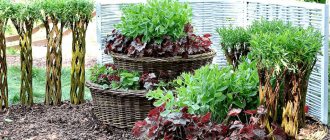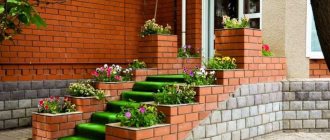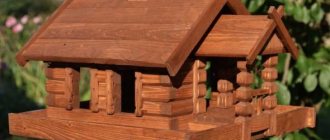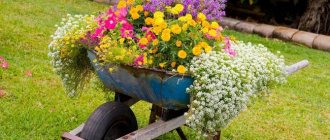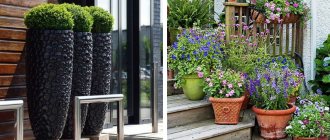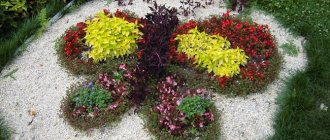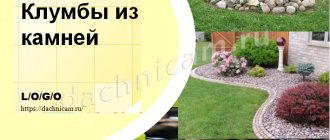Beautiful plantings are an integral decoration of the landscape of any dacha or personal plot. But even the most beautiful flowers can spoil the impression if they are planted chaotically and grow in the wrong place for them. This is why it is important to organize a flower garden. For this purpose, you can use a variety of materials, but the most successful is the use of wood. Numerous photos of flower beds made from boards with your own hands prove that such landscape decoration is no less interesting than those created by professional designers.
Pros and cons of wooden flower beds
Wood, as a material for various types of structures, including flower beds, has its advantages and disadvantages. If we talk about the advantages of flower beds made of wood, we can highlight the following aspects:
- environmental friendliness - the material itself is completely safe for humans, plants and the environment (even after rotting, wood can become an excellent fertilizer for flowers);
- safety for plantings - the tree does not get hot in the sun and does not freeze, which allows additional protection of plant roots;
- accessibility - wood is a fairly common material, which also has a reasonable cost, and besides, it is not at all necessary to use new wood;
- ease of manufacture - the material itself is easy to process, so it’s easy enough to make a flowerbed or fence of any shape and size from it with your own hands;
- aesthetics - the flowerbed can be made of various types, while it is possible to leave the tree uncoated (in its natural form) or paint it in the desired color;
- versatility - the tree is suitable for decorating flower beds in a variety of styles.
Among the disadvantages it is worth noting:
- fragility - since the material without certain treatment is quickly susceptible to rotting, damage by microorganisms and various insects;
- constant care - wood, as a short-lived material, requires annual treatment with special means or staining to maintain its original appearance. Important! When arranging any flowerbed made of wood, the material needs to be pre-treated with special compounds: antiseptic, oil or paint products.
- Varieties of decorative flower beds made of wood
They make a flowerbed with their own hands from wood in a country house or garden plot of the most varied formats. It can be stationary or mobile. At the same time, flower beds of the second type make it possible to install them each time in a variety of places, for example, near the entrance, under a window or a tree. Also, a big advantage of mobile flower beds is that they can be stored for storage in the winter, which will significantly extend the life of such a structure.
Depending on the shape and location, flower beds decorated with wood are also divided into types. So, for example, we should highlight the simplest one - this is a classic flower garden (flower bed), which is traditional. It is made of a certain geometric shape (circle, oval, rectangle or polygon). You can install it in any convenient place, usually at the entrance or under the windows.
No less popular is a wooden border for a flower bed. This design differs in location, as it is usually built along the paths.
Another most popular option is fencing, and it can be of several types:
- palisade - a fence made of stakes that are driven into the ground quite tightly to each other or at a short distance;
- wattle fence - a fence made of thin and long branches or shoots of bushes;
- picket fence - made of vertical boards fixed to a horizontal crossbar.
- DIY flower bed ideas from boards
Despite the simplicity of the material, you can still make a wide variety of flower beds from wood with your own hands. For example, boards can make unusual fences or classic geometric flower beds. But the saw cuts are suitable as decoration or decorative elements for flower garden design. All creation options directly depend on imagination, and some examples will be described below.
Selection and planting of plants
Plant ensembles can consist of both annual and perennial cultivars. It is advisable to plant varieties with a shallow root system and the same care requirements. The apothecary bed is often populated with unpretentious wild plants or sown with cultivated medicinal herbs. Hyssop, tenacity, oregano, basil, variegated plecranthus, various types of mint, fragrant rosemary, sage, and thyme are well suited for these purposes.
When planning to plant tall or climbing species, such as climbing roses, you must immediately install a support
It’s good if you manage to select plants in such a way that their flowering changes cyclically over the seasons, without requiring regular renewal of plantings. Then the flower garden will remain beautiful and varied for a long time, invariably attracting attention.
After the early flowering bulbs die off: multi-flowered daffodils (triandrus, jonkilliaceae, tazettas), tulips, crocuses, charming primroses can take their place. For the summer, it is appropriate to plant seedlings of low-growing ageratum of various colors, pansies, miniature daisies, decorative foliage and beautifully flowering hybrid cineraria. In the fall, small-petalled asters will open their buds. Anemones will decorate a flower bed both in spring and autumn. Perilla and coleus will delight you for a long time with the rich shades of leaves.
Choose plants as harmoniously as possible, highlighting the brightness of tall flowers with an edging of low “brothers” of delicate colors, or vice versa
In limited space, herbaceous and shrubby forms may need more nutrients and moisture, but you should not overdo it with fertilizers.
Flower beds made from boards for flowers
Flowerbeds made with your own hands from wooden boards are the simplest designs. This option is suitable for decorating absolutely any site, regardless of its size.
From this material you can make shaped flower beds, for example, in the form of a square or polygon. To do this, you will need to have a certain number of boards; for a square it will be enough to take only 4 of them, and for a polygon - depending on the number of its sides. In this case, the length of the board will be the height of the flowerbed itself.
It will be a little more difficult to make a sandbox flowerbed from boards. The principle of its construction is similar to the first option, but in this case the manufacturing process itself resembles the creation of a frame similar to a children's sandbox.
It is interesting to make beautiful small flower beds from boards in the form of boxes. Their advantage is mobility, since in general such flower beds can be moved around the site and removed altogether in the winter.
You can also make multi-tiered flower beds using boards. Such flower beds look impressive, and they require virtually no construction costs.
Flower bed ideas (4 photos + 1 video)
For climbing plants
A trellis made of bent mesh is installed between two wooden raised flower beds. Climbing plants are planted and a beautiful flowering arch is obtained.
From wooden pallets
Plants are planted in the gaps between the transverse boards of the pallet; if they are not wide enough, then some of the boards are first removed (usually one at a time). For such a flower bed, herbs or flowers that grow in bushes are better suited: marigolds, pansies, carnations .
From the boxes
The base is two longitudinal boards inclined at an angle of about 45 degrees, which are connected by cross members. Wooden boxes are installed on it, in which low-growing flowers or climbing plants that fall down are planted.
Longline
The shape can be anything from squares to pentagons and even stars. To make such a flower bed, you need to prepare frames from boards without a bottom (one frame for each level). The main thing is that each next tier is smaller than the previous one. Then, the first tier is installed and covered with earth. A second tier is placed on top and also covered with earth, and so on for each.
Flower beds made from wood cuts
In addition to boards, you can also use tree cuts, which also allow you to create original flower beds. Similar elements are also suitable for decorating flowerbeds made of other materials with wood.
From large cuts (logs) you can make flowerpots by removing the core. This void is then filled with soil. Despite the initial untidy appearance, after planting the plants, the flowerbed looks very noble and harmonious, blending with the environment.
Flowerpots from barrels
Old wooden barrels can also be turned into flowerpots. There are several options here:
- barrels are used as solid structures, then the containers required in volume and size are simply installed in them;
- or sawed both lengthwise and crosswise. In the first case, you will need to connect the boards to each other, in the second, two flowerpots can be made from cut barrels.
Photo source: www.stroychik.ru
Whatever option you choose for yourself, remember that the surface of the wood should be sanded and coated with protective varnish or paint.
Decorative fences for flower beds made of wood
Do-it-yourself wooden fences for a flower bed are the simplest option for decorating a flower garden. Such a fence always looks impressive and quite interesting. At the same time, the design can be made in a variety of ways, for example, if you use pegs, logs or a carved picket fence.
Often, flower beds are fenced with a more voluminous fence made of wooden beams. This solution is very original, allowing you to clearly separate the boundaries between the space of the site.
landscape architecture
Landscape design is an art created by specially trained people. However, in order to improve your garden, you do not need to graduate from a university in this specialty. To do this, you just need to have an idea of the basics of landscape architecture and adhere to them when designing your garden plot. Among the principles of garden design are:
- A complex approach;
- No congestion;
- Household wishes.
Firstly, you should transform your garden in a comprehensive manner, defining a suitable concept. To do this, all elements of the garden and the house itself are taken into account. It is necessary that the appearance of the building matches the garden and vice versa. There shouldn't be any contradictions. If the house is large, massive, made of brick, then features of strength should appear in the surrounding area. If the dacha is built in a sophisticated style, then a similar style is maintained in the garden. A solid wooden house acts as a fulcrum for creating a simple, but at the same time noble and unobtrusive design of the area. For the last option, do-it-yourself wooden flower beds are just right.
Wooden flower bed
Secondly, the garden space should not be overloaded. For convenience, the territory is divided mentally or schematically on paper into parts and each part is assessed separately, then all parts as a whole. Designers recommend leaving enough free space.
Note! A small private yard should not be filled to the maximum. All landscape elements should be compact and useful. Another thing is a large garden. In this case, majestic decorative forms are allowed, but again overloading the area is prohibited.
Thirdly, when arranging a site, it is important to take into account the wishes of all household members. It is worth providing a children's corner for children, and a gazebo for relaxing family members. It is also necessary to create a work area on the site. At the same time, aesthetics should be adhered to. The designer's task is to combine functionality and attractive appearance. Even if the garden area is small, neat paths, level beds, several evergreen crops, a flower garden and a bench will transform the space.
Flowerbeds made from tree branches
Unusual flower beds made from tree branches, or wattle as they are also called, are very attractive. Basically, such a structure is installed in the form of a hedge (decorative fence), but it is also possible to create flowerpots or flower beds in the form of baskets.
Attention! The most durable is horizontal wattle, but with vertical wicker you can create intricate patterns.
To make the most of your hand-made wicker wooden fence for a flower bed, you can plant decorative sunflowers nearby. In addition, the combination of wicker fencing with wildflowers looks great.
Rot protection
Wood has a significant drawback - it rots, since the boards of the flowerbed are constantly in contact with the ground and water. to protect and prevent rotting :
- Coat the boards from the inside of the flowerbed with clay - this will prevent contact with the ground and moisture;
- Cover the inside with waterproofing (for example, plastic film);
- Set the frame to dry annually (if the flowerbed is not used for perennial plants);
- Coat the inside of the flower bed with bitumen mastic. The mastic is diluted to the consistency of paint;
- Coat the flowerbed with waste oil. An effective, but not very safe method: in this case, it is better not to plant edible plants;
- Treat the boards with varnish, but leave the ends so that the wood can “breathe”;
- Use special antiseptics for wood.
Flower beds made of boards in the shape of an animal
Since wood is a material that can be easily processed, you can use it with your own hands to make not only simple flower beds in the form of geometric shapes, but also more interesting ones - carved ones. These include flower beds in the shape of animals, for example, a swan, a dog, an elk made of plywood or solid wood. A wide variety of figures of this kind can be made, but skill in using a jigsaw is required.
What are flower beds like?
Before making a flowerbed, let's first understand what it is. There are so many options for floral design of a site that it is easy to get confused: flower beds and flower beds, ridges, parterres, borders, modular flower beds, mixborders, rockeries, slides.
A flowerbed is a flower garden, usually of a clear geometric shape in the form of a circle, oval, or rectangle. In fact, in landscape design they are considered flower beds with a diameter of 1 to 30 meters. We doubt that on any private plot you can see flower beds 30 meters high - they are suitable for public parks and central city squares. And who will forbid us to build a flowerbed less than a meter in diameter? If we want, we will do it!
Flower beds are classified mainly by the filling with plants, namely by:
- longevity of flowering;
- type of planting material;
- flowering time;
- the nature of the landing;
- complexity of floral design;
- the nature of the arrangement of the picture.
In this article, we are not interested in the listed characteristics, but the form of construction and location are quite.
So, according to the form of flowerbed construction, there are:
- round;
- oval;
- square;
- rectangular;
- curly.
Of course, the curly ones are the most interesting, but they are also the most difficult to perform.
Based on their location, they are divided into central (main) and secondary. If we have a large plot, then it is unlikely that a wooden flowerbed will be central, unless it is all made in eco-style, but on a small summer cottage this would be quite appropriate. In any case, her style should fit into the overall design concept, if there is one. If not, then perhaps a wooden flowerbed will add a special flavor to our country property.
What else can we learn from landscape design? There is a point that must be taken into account unless, of course, we first want to make a flowerbed and then walk around it and think: “What’s wrong with it?”
- If the diameter exceeds 5 meters, the surface is made convex, with a slope of 5-10% (per 1 m - 5-10 cm).
- A small flowerbed may be level, but no one is stopping us from making a slope on it.
Flower bed made from scrap boards
If after repair or construction there are unnecessary cuttings of the board left, they will also be useful for creating an original flower garden with your own hands. In this case, you can make a low and simple fencing for a flower bed from scrap boards. Or collect neat small boxes that can be placed under a window or near a bench.
Using scraps of boards of different lengths, it is possible to create a kind of flower bed in the form of a ladder or a pyramid.
Tips for choosing plants for a log flower garden
When choosing a log 1 m in size and approximately 35-50 cm in diameter, the niche for planting flowers will be quite large. In this case, you can plant both annual and biennial plants. But when choosing a plant type, it is still worth considering the following:
- if the flowers have large leaves, then they must be planted very close, and with spreading greenery, the distance between the plants should be set back;
- It is better to plant taller flowers in the middle, and it is better to plant low-growing ones towards the edges;
- it is important to take into account the flowering period and decorative effect in the off-season; it is better to select varieties in such a way that they can replace each other;
- Don’t forget about the color combination; the flowerbed can be made in soothing colors or you can create a bright composition of contrasting colors;
- for more volume, you can plant decorative grass along the edge.
Important! When choosing flowers, you should definitely take into account the length and growth of the root system so that the plants are not crowded, and it is best to give preference to bulbous crops.
Flowerbed made of wooden pegs
Another simple type of fencing for a flower bed or large flower garden is a palisade, which is a low fence made of wooden pegs driven into the ground. They can be from a solid massif or from the trunks of young trees.
This type of fencing has a simpler method of implementation. You can install it as a border, as well as along the perimeter of the flower bed.
How to make a wooden flowerbed with your own hands
Making a flowerbed from wood or boards with your own hands is not difficult. The entire complexity will directly depend on what type of design was chosen.
Fencing made of pegs for a flower garden
If you don’t want to spend a lot of time creating a unique composition, then you can make a primitive, but at the same time quite decorative fence from pegs with your own hands. In this option, it is better to make a fence in a checkerboard pattern, that is, by alternately digging pegs of different heights into the ground.
To work you will need:
- round timber (logs) of the same diameter;
- shovel;
- varnish (stain).
Stages of work:
- To begin with, prepare the round timber. Logs are cut to 30 and 35 cm in length. If desired, strip them of bark.
- Then the outline of the future flower bed is marked. At the mark, they begin to dig a trench 15 cm deep. Insert pegs into the recesses and sprinkle them with earth, tightly compacting the soil around them.
- Logs are installed in a similar way along the entire marked perimeter.
- Finally, each peg is coated with varnish or stain. You can even paint it in different colors or make the fence a single color, but brighter (green, yellow, etc.).
Advice! In order for such a wooden flowerbed fencing to last for quite a long time, some of the pegs that will be dug into the ground can be treated with resin or oil.
Flowerbed-basket made of branches
An original flowerbed-basket, made with your own hands from tree branches, is suitable for planting small plants and flowers. It will look great at the entrance or near the porch. And to complete it you will need:
- the rods are thin and long (up to 1.5-2 m);
- the rods are thick;
- pegs;
- pruner;
- wire.
How to do it:
- Before starting work, prepare the material itself. The twigs are packaged into thicker and thinner ones, since branches of greater thickness should be woven in first.
- Then they mark the future flower bed and drive pegs around its perimeter. They begin to braid them. You should start weaving from the side that is less noticeable. For strength, it is better to fasten the rods together with wire. The pegs must be braided alternately (front to back). Each end of the branch must be secured with wire.
- At the end of weaving, the pegs are trimmed and the handle is started. To do this, weave a braid from the branches and insert its ends parallel to each other on the sides of the basket. It is also fixed with wire.
- A drainage layer is placed in the resulting flowerbed-basket, then soil, and suitable flowers are planted.
Flower bed made of boards in the form of a pyramid
A flower bed in the form of a pyramid of boards is quite attractive, and its features also include the fact that it is not so difficult to make this design with your own hands.
The shape of such a pyramid can have three or four corners, so before work you should definitely draw a drawing of a wooden flower bed and make the necessary measurements, followed by calculation of the required material.
You can make a flower garden from boards in a variety of sizes, but the most optimal is considered to be a pyramid with the following row sizes:
- first (lower) – 2x2 m;
- the second – 1.5x1.5 m;
- third – 1x1 m;
- fourth (upper) – 0.5x0.5 m.
The height of each level may be different, but the most suitable is 25 cm. It is optimal for the roots of many garden flowers.
Attention! It is better to build such a structure immediately at the place where it will be located, since in its finished form it is quite heavy.
For the work itself you will need the following materials and tools:
- boards;
- paint and varnish products (drying oil, varnish);
- fastening elements (nails, metal corners);
- glue;
- geotextiles;
- level;
- plane;
- hammer;
- PVC pipes (10 mm).
Execution steps:
- The very first thing is preparing the material. According to the drawing, all parts of the required size are produced and the required holes and grooves are made on them. Afterwards, the wooden boards should be treated with drying oil and varnished on top, and allowed to dry thoroughly (this action can also be performed after the assembly of the structure is completed).
- After all the boards are completely ready, they proceed directly to assembling the structure. It is better to connect the parts together using a special adhesive or using nails. The most reliable fastening will be using metal corners.
- The assembly of blanks from boards is carried out one by one, starting with the largest box. Then install the next rows. Before fixing each element, be sure to check its level position.
- The finished bed of boards is painted with paint of the desired color or additionally varnished, leaving the natural look of wood.
- Then geotextiles are laid along the entire perimeter of the base, which will prevent the growth of unwanted weeds. It requires several holes to drain water.
- This flowerbed, made with your own hands from boards near the house, is filled with soil and plants are planted.
Placement options on site
It will not be difficult to place a wooden flower bed over a large area. To do this, you need to find the most open place and install the selected flower bed there.
More hassle with arranging a not too wide area. If the area is already completely planted with plants and other types of plantings, this will complicate the task, but will not cause any special problems, since the optimal places can still be found in any case.
There is always an accommodation option Source zakustom.com
Photos of wooden flower beds with your own hands
Flowerbeds made with your own hands from wood will never go out of fashion; their popularity can be judged by numerous photos. Such flower beds today are not only a decoration for the landscape of any dacha or country house, but also an original way to create a cozy atmosphere on the site.
Advantages of wooden structures
Firstly, wood is environmentally friendly. Secondly, a flowerbed made from a log with your own hands costs practically nothing. Thirdly, thanks to the cheapness and availability of the material when creating it, we can fully use our imagination, and if something goes wrong, we can redo it or simply disassemble the structure. Fourthly, by constructing it, we not only decorate the territory and engage in creativity, but also free the area from rubbish that seems to be unnecessary, but it would be a pity to throw it away.
Of course, wooden structures are the most short-lived; they are susceptible to rotting and attack by pests. If you want them to last longer, treat them with used machine oil or another special product. Painting and varnishing also adds durability.
In addition, if the time comes for a flower garden made from cut down trees, they will not poison the ground, but as they decompose, they will serve as fertilizer and improve the structure of the soil.
It will be useful to read:
Path made of stumps in the garden When planning a country or summer cottage, you must pay attention to garden paths. It can be…
Custom shelves
A familiar flower shelf can be significantly transformed thanks to the decor used and unusual design. You can take unusual and stylish solutions as the basis for the design, but ensure they are practical and have maximum functionality while saving space:
- floating shelves mounted on the ceiling or walls;
- shelving made from wooden ladders or old stepladders;
- single and arranged shelves on the walls;
- horse trellises with shelves and hanging wicker flowerpots.
Maximum savings in free space are provided by corner cabinets, which can be converted into flower stands. To do this, the side walls are removed from the structure, and the shelves are located at a certain distance, which allows the flowers to grow and develop freely and receive a sufficient amount of light.
Important: In order for flowers to always delight with active growth and flowering, they must be well illuminated by natural light. You should not crowd the shelves too tightly with flowers and install pots at high heights; this will greatly complicate the process of watering and access to caring for house plants.
What materials are best to use for the stand?
In addition to the practical function of placing pots and saving free space, shelves should be as aesthetically pleasing as possible. To do this, after selecting the appropriate sketch, you should start choosing materials, which will help you correctly follow the instructions on how to make a flower stand with your own hands:
- metal for the manufacture of openwork forged stands with an original design;
- plastic or dense and lightweight monolithic polycarbonate with high wear resistance;
- natural wood and lumber with antiseptic impregnation and coating;
- tempered glass, it can be transparent or matte, colored material.
Often shelves and stands for flower pots are made from combined materials, carefully selecting their combination. The most common are designs with a wooden base and glass inserts as shelves, metal and glass, or a wood base and polymer shelves.
Selection of materials
When selecting materials, it is important to remember that they must be optimally combined with each other, be practical and wear-resistant. Lumber, metal structures, monolithic polycarbonate of different colors and even dense and opaque plastic are perfect for the base and shelves.
Suspended structures can be secured using ropes and reliable cords, chains and various alloys or wicker structures. Special attention is paid to the selection of fastening elements; these should be the most durable products that secure the entire structure, anchor bolts and furniture curtains, self-tapping screws and self-tapping screws.
Important: before working and assembling a floor stand for flowers with your own hands, it is important to ensure that all materials and their individual parts are processed correctly. Metal can be painted, but wood and lumber are artificially aged and fired, varnished or covered with carvings and original weaving.
